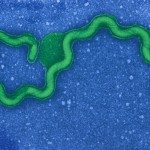Link to Pubmed [PMID] – 31120895
Link to DOI – 10.1371/journal.pntd.0007270
PLoS Negl Trop Dis 2019 05; 13(5): e0007270
The causative agents of leptospirosis are responsible for an emerging zoonotic disease worldwide. One of the major routes of transmission for leptospirosis is the natural environment contaminated with the urine of a wide range of reservoir animals. Soils and surface waters also host a high diversity of non-pathogenic Leptospira and species for which the virulence status is not clearly established. The genus Leptospira is currently divided into 35 species classified into three phylogenetic clusters, which supposedly correlate with the virulence of the bacteria. In this study, a total of 90 Leptospira strains isolated from different environments worldwide including Japan, Malaysia, New Caledonia, Algeria, mainland France, and the island of Mayotte in the Indian Ocean were sequenced. A comparison of average nucleotide identity (ANI) values of genomes of the 90 isolates and representative genomes of known species revealed 30 new Leptospira species. These data also supported the existence of two clades and 4 subclades. To avoid classification that strongly implies assumption on the virulence status of the lineages, we called them P1, P2, S1, S2. One of these subclades has not yet been described and is composed of Leptospira idonii and 4 novel species that are phylogenetically related to the saprophytes. We then investigated genome diversity and evolutionary relationships among members of the genus Leptospira by studying the pangenome and core gene sets. Our data enable the identification of genome features, genes and domains that are important for each subclade, thereby laying the foundation for refining the classification of this complex bacterial genus. We also shed light on atypical genomic features of a group of species that includes the species often associated with human infection, suggesting a specific and ongoing evolution of this group of species that will require more attention. In conclusion, we have uncovered a massive species diversity and revealed a novel subclade in environmental samples collected worldwide and we have redefined the classification of species in the genus. The implication of several new potentially infectious Leptospira species for human and animal health remains to be determined but our data also provide new insights into the emergence of virulence in the pathogenic species.



